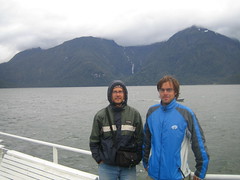La Paz, Bolivia,
People told us that La Paz´ setting as a city is one of the most amazing in the world, but any physical description we got doesn´t match what our eyes woke up to yesterday morning in the bus. As we were parked along the street for an hour and a half, for no apparent reason, just two blocks from the terminal, we waited for daylight. This revealed two things, almost everyone else had already gotten off, and two sheer cliffs on either side of the city covered with houses which seem to be stacked upon each other. The city centre is located at the bottom of a 400m canyon. The views only got better as we walked around, revealing beyond one cliff the snowcapped Illimani at an altitude of 6402m.
We are in the world´s highest capital, but we spent the weekend in the world´s highest city, Potosi. After our last blog on Friday, we took what was by far the worst busride of this trip. And it´s not because we were spoiled in Argentina. I had to force myself to stay awake because any position I fell asleep in resulted in a sore neck. There was no legroom, the whole trip was on a gravel road over a distance of 200km which took seven hours. Being a recovering diarrhetic didn´t help either. But hey, it was only $2.
Potosi is a beautiful city, a UNESCO world heritage site, with over 2000 listed colonial buildings, reflecting its rich heritage. The copper coloured Cerro Rico (Rich Hill), can be seen in the background. Potosi was founded in 1544, after the Spanish found out from the natives that there was silver, and alot of it, inside Cerro Rico. 30 years later it had a population of 120, 000, the size of London, and bigger than Paris or Madrid. The expression ´vale un Potosi´ or ´worth a Potosi´ which Cervantes had Don Quixote quote in his book, is still used in Spain for anything very valuable. Things were awesome for the Spanish, but for the natives and imported slaves from Africa life was very bad. I´ll spare you the details, but it is said that 9 million workers died in these mines over a period of 200 years.
Our main reason for coming to Potosi was to visit one of these mines. Bolivians still mine them, but now for less lucrative metals like tin and copper. There is very little silver left. Our tourguide was Pedro, a former miner who spoke English perfectly, as well as four or five other languages. When visiting a mine it is a custom to buy dynamite, glycerine, fuses, and pop to give to the miners as a gift. There weren´t many miners, since it was Saturday, but we were able to visit with some, being greeted by an enthusiastic ´Hola, Gringitos´, every time we walked by. One of them was only 15 and had been working there for three years. Many miners only work for 20 years. Those who keep working usually die from lung disease between the age of 45 and 55. That´s not hard to understand. We spent two hours underground, at moments manouvering through a shaft just large enough for our bodies. There was a constant thick grey dust in the air, impossible to not breathe in. Somehow, the miners were all in good spirits, joking the whole time. Pedro told us that was the only way for them to forget about the conditions they were in. This was an eye-opening experience for us, but thankfully that also meant some things weren´t quite as bad as we thought. One guidebook said that miners die ten years after entering the mine. That´s not true. We were also told that, though some make very little, most miners make a decent living. I don´t mean to make it sound like a good job though, cause it´s not. It´s hard work, it´s dangerous, and it would take someone alot stronger than any North American or European that I know to be able to do it.
After the visit to the mine came the fun part. I got to stick a fuse into a stick of dynamite and hold it while it was lit. This was a milestone in my pyromania career. Then the guy ran with it, put it in the ground, and five seconds later it exploded. Just kidding, it was more like 5 minutes. The rest of our time in Potosi was spent eating, not going to a Bolivian wedding (Pedro invited us but didn¨t realize the groom was from a rich family, so we couldn´t get in even though we bought gifts and everything), and watching Real Potosi beat Aurora Cochabamba 2-0 on a perfect, hot Sunday afternoon.
Manana, vamos en bicicleta en el camino mas peligroso del mundo. Moms and sisters, I wrote that in Spanish for a reason, translate it at your own risk. I´m sorry, but we used up all our space on flickr so we won´t be able to put on more pictures till May 1.
Thanks for reading,
Pieter


1 Comments:
Just wanted to let you know I am still checking in and I have to say that the pics are great and the reporting style is becoming almost professional. At least Pieter's is... just kidding Clay. Do you need donations for bus money? Maybe you should send your "articles" to a paper back home. Just a thought.
Post a Comment
<< Home